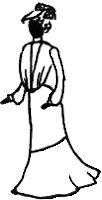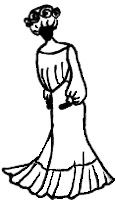Упражнение на лексическое преобразование слов. Рекомендуем всем, кто готовится к сдачи ЕГЭ по английскому языку.
Прочитайте приведённый ниже текст. Образуйте от слов, напечатанных заглавными буквами, однокоренные слова, так, чтобы они грамматически и лексически соответствовали содержанию текста.
ЗаданиеОтвет
The Edwardian fashion
1901 starts out the era with the Trumpet Skirt; a shaped skirt that is fitting over the hips and thighs, then fl aring out below the knee for a wide hem, ( TYPICAL ) in either 5 or 7 gores.
Very quickly, the slim skirts begin to get fuller at the hem, with the ( ADD ) of vertical pleats and tucks around the skirt, though the skirt remains lean and controlled through the thigh.
The Edwardian style begins in 1902 with the ( INTRODUCE ) of the straight front corset, and the S-bend or pidgeon-breast figure.
The emphasis was placed on an overall ( SLIM ) of the female form, and corsets were designed to compress the waist and lower abdomen, but no longer support the bosom.
The bosom now became the lowered mono-bosom, made possible by the use of ( VARY ) methods of exaggeration, such as ruffles, padding, pneumatics, or bust forms.
As the new century ( FOLD ), the fitted bodice looses favor.
The Edwardian fashion
1901 starts out the era with the Trumpet Skirt; a shaped skirt that is fitting over the hips and thighs, then fl aring out below the knee for a wide hem, typically in either 5 or 7 gores.
Very quickly, the slim skirts begin to get fuller at the hem, with the addition of vertical pleats and tucks around the skirt, though the skirt remains lean and controlled through the thigh.
The Edwardian style begins in 1902 with the introduction of the straight front corset, and the S-bend or pidgeon-breast figure.
The emphasis was placed on an overall slimness of the female form, and corsets were designed to compress the waist and lower abdomen, but no longer support the bosom.
The bosom now became the lowered mono-bosom, made possible by the use of various methods of exaggeration, such as ruffles, padding, pneumatics, or bust forms.
As the new century unfolds, the fitted bodice looses favor.
Задание №5695.
Грамматика и лексика. ЕГЭ по английскому
Вставьте слово, которое грамматически и лексически будет соответствовать содержанию текста.
The Edwardian fashion
1901 starts out the era with the Trumpet Skirt; a shaped skirt that is fitting over the hips and thighs, then flaring out below the knee for a wide hem, ___ (TYPICAL) in either 5 or 7 gores.
Решение:
The Edwardian fashion
1901 starts out the era with the Trumpet Skirt; a shaped skirt that is fitting over the hips and thighs, then flaring out below the knee for a wide hem, TYPICALLY in either 5 or 7 gores.
Эдвардианская мода
1901 год открывает эру юбки-труба; юбка формы, которая облегает бедра и бедра, а затем расширяется ниже колен для получения широкого подола, обычно с 5 или 7 выступами.
Показать ответ
Источник: Английский язык: 10 вариантов ЕГЭ. К. А. Громова, О. В. Вострикова, О. А. Ильина и др.
Сообщить об ошибке
Тест с похожими заданиями
Посетители, находящиеся в группе Гости, имеют ряд ограничений .
После регистрации будут доступны все ссылки для скачивания, открыты комментарии, а также скрыта реклама на сайте.
A super cute lacy dress inspired by Edwardian fashion! Friendly to curvy girls as it has larger bust size and adjustable waist!
Fabric: 97% Polyester, 3% Spandex
Size information:
S bust 87cm/34» length 112cm/44»
M bust 91cm/36» length 113cm/44.5»
L bust 95cm/37.4» length 114cm/44.9»
Free waist
Упражнение на лексическое преобразование слов. Рекомендуем всем, кто готовится к сдачи ЕГЭ по английскому языку.
Прочитайте приведённый ниже текст. Образуйте от слов, напечатанных заглавными буквами, однокоренные слова, так, чтобы они грамматически и лексически соответствовали содержанию текста.
ЗаданиеОтвет
The Edwardian fashion
1901 starts out the era with the Trumpet Skirt; a shaped skirt that is fitting over the hips and thighs, then fl aring out below the knee for a wide hem, ( TYPICAL ) in either 5 or 7 gores.
Very quickly, the slim skirts begin to get fuller at the hem, with the ( ADD ) of vertical pleats and tucks around the skirt, though the skirt remains lean and controlled through the thigh.
The Edwardian style begins in 1902 with the ( INTRODUCE ) of the straight front corset, and the S-bend or pidgeon-breast figure.
The emphasis was placed on an overall ( SLIM ) of the female form, and corsets were designed to compress the waist and lower abdomen, but no longer support the bosom.
The bosom now became the lowered mono-bosom, made possible by the use of ( VARY ) methods of exaggeration, such as ruffles, padding, pneumatics, or bust forms.
As the new century ( FOLD ), the fitted bodice looses favor.
The Edwardian fashion
1901 starts out the era with the Trumpet Skirt; a shaped skirt that is fitting over the hips and thighs, then fl aring out below the knee for a wide hem, typically in either 5 or 7 gores.
Very quickly, the slim skirts begin to get fuller at the hem, with the addition of vertical pleats and tucks around the skirt, though the skirt remains lean and controlled through the thigh.
The Edwardian style begins in 1902 with the introduction of the straight front corset, and the S-bend or pidgeon-breast figure.
The emphasis was placed on an overall slimness of the female form, and corsets were designed to compress the waist and lower abdomen, but no longer support the bosom.
The bosom now became the lowered mono-bosom, made possible by the use of various methods of exaggeration, such as ruffles, padding, pneumatics, or bust forms.
As the new century unfolds, the fitted bodice looses favor.
Время неумолимо летит, и вот уже сентябрь подходит к концу, а это значит, что пора основательно заняться подготовкой к грядущему ЕГЭ по английскому 2022. И как вам, наверное, известно, раздел «Лексика» — один из тех разделов, на подготовку к которому уходит довольно много времени. Поэтому предлагаем вам прямо сейчас начать расширять свой словарный запас и запоминать небольшие хитрости, которые помогут легко и просто выполнять задания 32-38. А поможет вам это сделать наша новая статья «Edward ЕГЭ: детальный разбор и ответы».
Читайте, берите на заметку и делитесь со своими друзьями.
Edward ЕГЭ: детальный разбор и ответы
Сначала посмотрим на сам текст «Edward ЕГЭ», который представлен на сайте ФИПИ.
А32. Первое задание начинается с проверки устойчивого выражения make a call – звонить. Запоминаем его, оно довольно часто встречается в заданиях 32-38.
Edward wanted to 32 ______ a call to his lawyer and ask him some questions.
Ответ:
- do
- give
- make
- take
Ответ: make
A33. Cледующее задание на уже не раз встречавшийся синонимичный ряд look, watch, stare, gaze. Более подробно мы рассказывали об этих глаголах в одной из наших статей. Если вы еще не читали, то обязательно сделайте это. Там мы рассказываем о разнице между ними и приводим список устойчивых выражений с этими глаголами. Кроме того, вы можете закрепить полученные знания, выполнив тест по данной теме.
Возвращаемся к нашему заданию. Как обычно, начинаем с того, что смотрим, что стоит после пропуска.
Opening the French doors, he stepped out onto the terrace and stood for a moment 33 ______ the sky.
Ответ:
- looking
- watching
- staring
- gazing
Там мы видим прямое дополнение. Это позволяет сразу исключить из претендентов на правильный ответ looking, staring, gazing, так как после них дополнение идет с предлогом at. Остается watching, именно он и будет правильным.
Ответ: watching
A34. Подобное задание мы не раз уже разбирали. Здесь достаточно посмотреть на слова после пропуска, где мы видим инфинитив с частицей to. Он употребляется после used, чтобы рассказать о привычках, которые были в прошлом, но сейчас их больше нет.
Если среди предложенных вариантов ответа есть used, то велика вероятность того, что именно он и будет правильным. Однако, не забывайте проверять и остальные слова, ведь среди них также составители могут дать те, после которых будет to+инфинитив.
He knew if he walked down the long garden path, he would come to the strip of land where he and his brother 34 ______ to play many years ago.
Ответ:
- took
- kept
- held
- used
Ответ: used
А35. Перед нами еще одно задание, проверяющее знание устойчивых выражений. Давайте посмотрим, что после пропуска.
If only he could 35 ______ his friends’ advice…
Ответ:
- search
- ask
- seek
- pose
Там мы видим прямое, то есть беспредложное дополнение his friends’ advice. Такое возможно только в случае с глаголом seek: seek smb’s advice – просить чьего-то совета. Хотя стоит заметить, что среди предложенных глаголов есть еще один, который в сочетании с advice даст тоже самое значение, — это ask. Однако, он требует предложного управления for: ask for advice — просить чьего-то совета.
Ответ: seek
А36. Сегодняшние задания на лексику пестрят устойчивыми выражениями. И вот еще одно: pay attention to smth – обратить внимание на что-то.
Также существительное attention может сочетаться и с глаголами draw (drew) и turn (turned), но при этом выражения приобретают другой оттенок. Подробно об этом мы рассказывали здесь. А если уверены, что знаете, чем они отличаются друг от друга, то предлагаем выполнить тест.
He 36 ______ no attention to what his friends had been telling him.
Ответ:
- brought
- paid
- drew
- turned
Ответ: paid
A37. Ну и куда же без выражения to tell the truth – по правде говоря. Это частый гость раздела Лексика, поэтому неприменно выучите его. Остальные устойчивые выражения с глаголами say, tell, speak, talk вы найдете здесь, а также узнаете, в чем между ними разница. И не забудьте потренироваться в их использовании и пройти тест.
To 37 ______ the truth, he had made many mistakes with George.
Ответ:
- tell
- say
- speak
- talk
Ответ: tell
A38. Перед нами синонимичный ряд accept, admit, adopt, agree. О нем мы рассказывали во всех деталях здесь, поэтому совсем кратко обоснуем выбор ответа.
He had to 38______ making a fatal mistake.
Ответ:
- accept
- agree
- admit
- adopt
После пропуска стоит глагол с окончанием — ing, такое возможно только после глагола admit. В данном случае он употребляется в значении «признать, что что-то сделано не так».
А вот и тест, посвященный этой теме. Скорее выполняйте, ведь практика лишней не бывает.
Ответ: admit
Множество тематических тестовых заданий из раздела 32-38 вы можете найти в нашей рубрике «Задания 32-38». А еще больше подобных разборов ищите в нашей новой рубрике «ФИПИ ответы». Кроме того, проверить знание лексики ЕГЭ вам поможет наш тест.
А за разговорной практикой и изучением других непонятных и интересных тем, приглашаем на наши онлайн-занятия. Отправьте заявку и занимайтесь английским в любое удобное вам время.
Разбор следующего текста «A trip to Thailand» уже совсем скоро. Следите за обновлениями и совершенствуйте свой английский вместе с ABC.
After the 19th Century, the masculine and tailored look gave way to feminine charm. Femininity categorized the Edwardian era in terms of clothing and fashion.
1901 Trumpet Skirts
At the start of the era, Trumpet skirts became very fashionable.
They were tight on the hips. They flared out below the knee into a wide hem. It had a typical of 5 to 7 gores. It had a flared look that touched the ground. Soon the slim skirts began to be fuller at the hem. Vertical pleats which gave the skirts a straight in the up and fuller look at the bottom made inroads in Victorian Fashion Bustle.
Edwardian Fashion Plates and the Late Bustle -1900-1910
The dresses were very feminine and beautiful.
The skirts were generally lean and fitted at the hip and thighs. The tucks increased to give the skirts a flared look.
The Edwardian Fashion Plates and Edwardian Bustle Gowns started predominantly by 1902. The straight cut front became fashionable.
S-Bend and Pidgeon Breast Figure Dresses
By this time, the emphasis and attention shifted to the women’s figures. Dresses were created to accentuate the female form and figure. The dresses were made to give the illusion and effect of a thin waist and were tight at the hips. It compressed the lower waist and abdomen.
The bosom and breasts now became the lowered mono-bosom. The upper part of the bodice and corset used paddings, ruffles, and stuffing to create a fuller look in the bust forms.
Rump Pads at the hips became common
The addition of rump pads at the hip and back of the corset gave the illusion of an arched back and a round shaped back. This completed the look of how a woman’s body was supposed to look.
Fashion and style at the turn of the century
In the 1890s the blouse waist and shirtwaist commenced but they really became popular by 1902. During this time, the fitted bodice became less favored and the bosom shifted a bit lower.
By 1904 straight gores became really in and fashionable. Skirts became trendy and had additional gores. 9 to 12 gores were extremely common. Sometimes, skirts had up to 24 gores.
By 1905, circular skirts became fashionable cut in one piece. By 1906, the skirts move towards a slimmer design. The skirts had straight gores and a slim look. This fashion continued until the end of the century.
Trimmings were flat. Sometimes ruffles were used on the hem of the skirt.
Fabrics used
The fabrics were generally light like muslin, satin, woolen, linen. The flowy fabrics added a willowy look to the skirts making them even more desirable.
Silk taffeta also became popular. Skirts were generally long lined. Foundation skirts were made of silk taffeta.
Multi-layered petticoats were needed to support the skirts. This completed the entire look and added elan.
Sleeves
In the early years, the sleeves were slim at the shoulders which later became fuller. By 1904 the sleeves became fuller at the elbows and by 1906 at the shoulders. The cuffs were fitted at the wrists giving a crisp and well-finished look.
Necklines
Necklines were high. They were decorative and stylish. Duchess square, Duchess neckline, and Jewelled look became fashionable.
Slim Hobble Skirts
Hobble Skirts became popular in 1909. Hobble skirts were slim and long lined. In fact, they were the slimmest versions of skirts.
The 1913-1914 fashion
By 1913 skirts became narrow and draped styles also became quite fashionable and were widely accepted in French designs. 1915 skirts were more of an A-line shape which looked pretty. By 1916, the skirts became again quite full and short.
Edwardian Fashion and Gown Designs – Modern Looking Clothing and designs
The Edwardian era covers the short reign of King Edward VII and lasted from 1901 to 1910. It was an era of luxury with elegant dresses, expensive fabrics and trimmings. Even lingerie was lavishly trimmed with rows of lace for the first time in history! Moreover, Edwardian fashion was characterized by the new S-bend corset, the pouter pigeon shape, high collars and hats. While high collars and hats remained popular throughout the era, the pouter pigeon shape decreased over the years.
Dresses were always two-piece garments in the early Edwardian era consisting of a skirt and matching bodice which were separate at the waist. Only since the middle of the Edwardian era, one-piece dresses became available. The first one-piece dresses were known as suspender bodices and jumper skirts in the Edwardian era.
There was also a change of sleeve in the Edwardian era: Early Edwardian close-fitting sleeves evolved into bishop sleeves, which were close at the shoulders and wide at the wrists. While the mid and late Edwardian era saw a return of the 1890s leg-o-mutton sleeves which were wide at the shoulders and close at the wrists.
And even if Edwardian skirts look similar, the skirt silhouettes also changed: At the beginning of the Edwardian era, skirts were close at the hips and knees with a wide flounce below the knees. Such skirts were called trumpet or tulip skirts. In the middle of the Edwardian era, circular skirts were fashionable, while in the late Edwardian era skirts became narrower.
Edwardian Fashion – Dating Edwardian Photographs & Dresses
Look For These 12 Details When Dating Antique Edwardian Clothes
Sleeves
- bishop sleeves: 1901-1903/4
- leg-o-mutton sleeves: 1905-1908
- short sleeves (even in winter): 1906
Skirts
- tulip skirts (close at the hips and knees with a flounce at the bottom): 1900-1903
- circular skirts & pleated skirts: since 1904
- pleated skits: especially 1904-1909
- narrow skirts: since 1909
Dresses
- especially frilly, fluffy summer dresses: 1903 & 1905
- suspender bodice (skirts with straps over the shoulders): 1905/6
- one-piece (jumper) dresses: since 1907
Lace & Embroidery
- early Edwardian era: delicate, dainty embroidery and lace
- late Edwardian era: rather coarse lace, mixed lace and bold embroidery patterns
Related: How To Dress In The Edwardian Era
4 Things To Remember When Dating Antique Edwardian Photographs
- clothes were sometimes worn for more than a year – especially expensive silk dresses and hand-sewn lace dresses
- tailored wool skirts and dresses were worn for 5 or 10 years, so they’re not good to date photographs
- clothes were refashioned: e.g. bishop sleeves were cut off and turned into leg-o-mutton sleeves
- shirtwaists (blouses) and accessories, such as hats, are great to date photographs. Even less well-off women and working women bought (or remodeled) a new hat each season.
Related: How To Dress For Business In The Edwardian Era
 1900
1900
- new figure: shaped with straight front (S-bend) corsets
- rather masculine fashion style
- fashion and hairstyles still influenced by the 1890s
- close-fitting sleeves (the leg o’mutton sleeves of the 1890s are gone)
- small hats with high crown
Bodice
- straight front
- round or slightly dipped waist
- double-breasted jackets and blouses
- wide collars & bodices with round yoke style
- back closure
- close-fitting sleeves
Skirt
- circular skirts, one-piece to five-gored skirts
- close at the top
- slight flare at the bottom, about 3 yards wide
- skirts with inverted box-plait in the back seam or the new habit back (how to sew a habit back (1911 source)
- kick-pleats in the front side seams
- sweep or round length; instep or shorter length for shopping, touring or sports
Evening Gown
- Empire evening gowns
Accessories
- large fans worn with evening gowns
- pointed shoes
Hat
- small hats with high crowns
Hairstyle
- pompadour hairstyle with tiny, high bun on top of the head & hair close at the back
 1901
1901
- pouter pigeon shape begins (with dipped waist)
- vertical tucked shirtwaists
- sleeves with decoration at the wrists
- skirts with more flare at the bottom
- hats with bent brims
Bodice
- pouter pigeon shape begins
- slightly or decided dipped waist
- shirtwaist with vertical clusters of tucks
- jacket-style bodices with simulation vest piece or bodices in square yoke style:
- ‘Frequently this trimming forms a short bolero that terminates above or just below the bust.’ (source)
- close fitting sleeves with decorations at the wrist
- back closure remains popular in shirtwaist and dressy bodices (source)
- bodice back drawn down
- bodices with fitted lining
- cloth dresses in ‘Louis treize style’ with wide collars and revers
- Irish lace trimming is popular on dresses, coats and hats
Skirt
- skirts still close at the hips with wide, circular flounce at the bottom: 1901 tulip skirt pattern, skirt width around the bottom: 3 3/4 – 4 1/2 yards, a ‘new mode’ are circular skirts with habit back and a ‘graduated circular flounce’ (source)
- skirt embroidery in VanDyke (zig-zag) design: ‘Six points are formed on the skirt, top and bottom’ (source)
Coat
- short coats and jacket in the same or a different material and color as the skirt
- double-breasted jackets with dart-fitted fronts
- bell sleeves
- ‘Norfolk effects in shirt-waists as well as jackets are one of the most important features of the season’s styles’, such as box pleats on the front and back (source)
- in winter: fur Empire coats with satin lining, chiffon frills and Irish lace trimming: sable, chinchilla and ermine fur is especially popular (source)
Evening Gown
- straight-front effect
- ‘skirts fit close to the figure, but have a great deal of flare below the knees‘ (source)
- evening bodices with low square, low round or high neck
- short, elbow-length or long sleeves
- ball gowns of thin materials, such as net, gauze, chiffon, or sequin-embroidered lisse, lace, soft silk and brocaded satins, but stiff brocades are no longer worn as ball gowns
- white and pastel colors
- artificial flowers ‘are much used both for hair ornaments and as trimming on the gown […] [some with] the dewdrop effect of rhinestones or diamonds.’ (source); evening gowns with ‘the picturesque fichu, deep frills of lace on the sleeves and lace-robed fronts […] garlanded with chiffon roses amid leaves embroidered in green ribbon […] revival […] of passementerie trimmings, […] silken tassels’ (source)
Accessories
- long pearl necklaces worn with afternoon and evening dresses
- ‘The newest neck chains are very massive and much ornamented, while the curiously fine, almost threadlike chains, glittering with tiny diamonds set in platinum, are much worn and very beautiful. Gems of all kinds are literally draped over the shoulders of evening bodices’ (source)
- ‘The Fox boa in white, and gray and in black continues to be seen about the neck of fashionable women’ (source)
Hat
- ‘artistically bent’ brims, a new hat style ‘which rolls high on each side’ (source)
- toque and tricorn hats
- soft beaver felt – a new material for hats (source and fashion plate)
- ‘Birds and ostrich feathers are the favorite trimmings for millinery […] Hats are flat in […] style of trimming’ (source)
Hairstyle
- wavy pompadour hairstyle with small bun on top of the head: the ‘alteration in the coiffure, which is to be removed from the top of the head to below the crown, comes slowly but surely’ (source)
Related: Authentic Edwardian Pompadour Hairstyle Tutorial
 1902
1902
- bishop sleeves
- bodices with bayadère tucks (horizontal tucks)
- hats turned up on one side
Bodice
- pouter pigeon shape with dipped waist
- two-piece costumes with wool jacket and skirt
- tucks en bayadère (horizontal tucks) & pintucks are popular (source)
- dropped shoulder effect with high, round Dutch or 1830s low neck style: A chief characteristic of the new waists and bodices is the drop-shoulder effect, achieved either by the shaping of the garment or by the disposition of the trimming. […] with high or round neck’ (source), lace collars ‘so large as to look almost like a cape’, summer gowns with fichu bodices (source)
- slot-seam effects
- bishop sleeves: ‘wide and ample at the wrist and tight-fitting at the shoulder’ (source), sleeves with epaulettes
- long and elbow-length sleeves (source)
- yellow, orange and intense blue are ‘a fad; [but] they are not becoming and have nothing but novelty to recommend them’ (source)
- shirtwaist with or without body lining and with front closure with buttons and buttonholes or eyelets and studs (source)
Skirt
- still narrow at the hips and full at the hem (source), width at the hem: 4 1/8 – 5 3/8 yards: ‘There is one model to which Dame Fashion is faithful. The plain, close-fitting skirt with the foot flounce. True, she varies the flounce and makes it a Spanish ruffle, deeper in the back, or she points it along the top, or she side plaits it, or she takes it and sets a fluffy ruffle under it. But on all the new gowns you will see this volante, or on so many of them.’ (source)
- tunic skirt with flounced frou-frou effect (source and fashion plate)
- five-gored, seven-gored and nine-gored skirt with or without circular flounce: the ‘nine-gored flare skirt in frou-frou effect at the lower edge […] closely fitted to the knee […] in habit style or with an inverted box-plait at the back […] is known as the eel-skin or mermaid skirt (source)
- skirt box-plait left free or stitched down in habit style (source)
Coat
- kimono coat with bishop or flowing sleeves: ‘They fall below the knees, are collarless, have immense sleeves caught in at the wrists, and are held together in front by long twisted silk cords, which tie and have tasseled ends.’ (source)
- ‘Monte Carlo coat […] in three-quarter or hip length, […] its distinguishing characteristics are the drop-shoulder yoke and an Ascot stock […] the smartest design for the coat to be worn with walking skirts is the loose or box Norfolk mode, with stitched straps and belt of the material’ (source), Louis XV coats (source),
- military-style coats in dark blue with gold buttons (source)
- ‘the fronts roll back in revers’, trimmed with ‘stitched straps’ (source)
- ‘made in all colors, scarlet, mignonette, green, champagne, putty, brown bread which is one of the favorite tints, not Boston brown bread but the more delicate Graham’, black and white (source)
- trimmed simple – ‘the most attractive’ – with just some guipure at the neck, or elaborate with Irish lace strips. (source)
Evening Gown
- ‘The princesse style is much used, with a broad belt, however, pointed in front and round at the back’ (source)
- black and white lace dresses lined with chiffon over satin, chiffon and brocade evening dresses – brocade evening gowns can later be refashioned into a petticoat (source): ‘There never was a greater display than at present of white lace dresses of every description for afternoon and evening wear. Irish lace, English embroidery, Chantilly mixed with Cluny are worn in abundance and in a profusion which sends us to hunt through the forgotten heirlooms lest there be a dozen odd bits of as many sorts with which we can make at least a bodice!’ (source)
Accessories
- lace mitts are worn with ‘elbow sleeve dresses’ (source)
- white kid accessories (source): white kid gauntlets ‘lined with coloured kid, undoubtedly chic, new, and, alas, most expensive’, ‘White kid shoes worn with stockings to match the colour of the dress […] and the most elegant of all foot gear at present is undoubtedly the gray Suede shoe which is worn with stockings in a shade of gray to match’ (source)
- long pearl necklaces worn with evening gowns
- twin pins for the ‘front and back of the stock’ (source)
Hat
- hats no longer flat but turn up on one side with flat crowns
- less black hats
- hats are decorated with ombre plumes, fruit gardens, and white lace like a wedding veil which is ‘mal porte except for those who do not leave their carriages in an afternoon promenade’ (source), hats with picturesque ‘pendant drapery over the hair at the back, […] made either in chiffon, or in lace, or in ribbon’ (source)
Related: Edwardian Easter Hats
Hairstyle
- smoother pompadour hairstyle with bigger, less high bun
 1903
1903
- fluffy, frilly, feminine dresses: lace, ruffles, sheer cotton materials
- S-silhouette
- bishop sleeves: wide around the wrist, but close at the shoulder
- wide ‘frou-frou’ skirts
Bodice
- ‘Gibson’ shaped bodice with pouching front drooping over the belt: ‘waist as big and easy as it can be made without having a baggy effect’ (source)
- the French curve instead of the extreme dip: ‘the hips are slender, the bust raised a trifle more than it has been, and the belt […] has decidedly lost the extreme dip effect in front (source)
- soft materials (source): sheer cotton materials, such as dotted Swiss, for summer, and soft wool fabric for winter
- ‘romantic and elegant’ style (source)
- vertical tucked bodices
- full, soft flowing and wide bishop sleeves but still tight at the shoulder
- drooping collars; ‘Every means of broadening and increasing the drooping effect of the shoulders is sought’ (source)
- two-piece costume (worn in winter with fleece-lined cotton shirtwaist)
- shirtwaist with large buttons
- shirtwaists with or without fitted linings
Skirt
- long skirts
- fits closely at the top with wide flare at the bottom: 4 1/2 – 5 1/2 yards, even tailored skirts flare at the bottom
- skirts with tucks, pleats, ruffles, or plain: ‘have the skirt fit as tightly as possible, and still, by means of side and box plaits, preserve the impression that it is a full skirt’ (source)
- seven-gored, and nine-gored wool skirts trimmed with taffeta with or without tucks (source), skirts with hip yokes
- skirts with box pleat at the back or habit back
Evening Gown
- ‘The skirts of ball gowns are being made shorter’, hems have ‘gone out of fashion’ (source)
- some ball gowns have now ‘only a strap across the shoulder’ (source)
- evening gowns with high or low waists; some wear long princess line dresses without trimmings
- white and pastel colors are still fashionable, but also bright green or bright red
- ‘of late there has been so little difference made between the materials used for the different seasons’: so velvet and satin are worn in summer, and lace and thin materials in winter, ‘Flowered muslins, batiste, and crêpe de chine gowns are in fashion again for evening wear (source)
Accessories
- small fans worn with evening gowns
- fine, white lace mitts or ‘coarse renaissance lace [mitts] dyed to match the color of the costume’ (source)
- boas: ‘the boa is now the mark of the pretty girl, and you do not catch her out without it’ (source)
- stock-collars, cuffs and belts with tabs (source)
Hat
- hats with flat crowns (source)
- projecting front hats – ‘called the “Woffington” poke’ – ‘made with a conspicuously short back, as all the new hats are […] The trimming is principally massed at the back […] Under the poke close up to the hair a chou of soft ribbon may be tucked, or perhaps two linked wreaths of forget-me-nots, or any dainty small flower.’ (source)
- simple trimmed hats, trimmed with flowers and grasses
- hat veils matching the color of the hat (source)
Hairstyle
- soft pompadour hairstyle with chignon high on the head or at the back of the head
 1904
1904
- pleated skirts, kimono-style boleros
- drop shoulder
- sleeve width increases: bishop or leg-o-mutton sleeves
- bodices usually with back closures and fitted linings
Bodice
- bodices with bayadere tucks (horizontal tucks), draped in surplice style (source), or with fichu trimmings (source)
- bodice back either bloused or drawn down
- back closures are preferred, even for shirtwaists
- wide bishop or leg-o-mutton sleeves, long or three-quarter length
- deep yokes with ‘drop shoulders’
- kimono boleros: ‘a smart cape coat know as the Samurai jacket […] jacket and sleeves are in one […] A collar facing, extending over the shoulders in epaulette style’
- epaulette caps (source and fashion plate)
- dressy gowns: shirred or trimmed with puffed bands
- new dress materials are flowered chiffon and brocades ‘in single tones and in contrasting colours; waist round for day wear, dipped for evening wear; button trimmings: suede-covered buttons, jewel-like buttons, canvas buttons with cross stitch embroidery (source)
Skirt
- circular and gored skirts with or without circular flounce;
- yoke skirts
- pleated skirts: ‘kilted modes are very popular for general wear’; the new kilt plaiting ‘is formed of thirteen gored sections and arranged in a plait at each seam and in the middle of each gore […] Tuck-stitching to any desired yoke depth holds them in position, and below they fall free to the lower edge, where a pretty effect is produced in walking’ (source)
- skirt width at the hem: 3 7/8 – 5 1/4 yards (source) or even more: ‘The woman whose gown does not measure eight yards about the hem of her skirt is our of style – dowdy.’ (source)
- skirts shorter than the year before (source)
Coat
- coats in various length: ‘The fitted coat is much favored and is equally popular in seven-eighths, regulation and short three-quarter and long hip lengths’
- bishop or leg-o-mutton sleeves (source)
- fur mantelets & long coats trimmed with fur (source)
Evening Gown
- empire gowns
- evening bodice with Dutch round or square neckline (source)
Accessories
- belt buckles (now round or oval) are worn at the back and the belt ‘is fastened in front with a small clasp’ (source)
- ‘The newest fur boas are no longer flat, but round […] a novelty are the little eiderdown boas only about three-quarters of a yard long, worn close around the neck‘
- laced boots out of fashion (source)
- granny shawls (source)
Hat
- small for street, big for dressy wear (source)
- variety of hats: tricorne hats, turbans, toques, Louis XVI and Directoire hats with strings tied under the chin, turned up brims, high crowns: ‘the high crown is considerably modified in some models by folds and bands of ribbon or tulle puffings […] A favorite shape is the medium-sized capeline with slightly drooping brim and high crown’ (source), ‘This season’s close-fitting hats have brims projecting in front and rather low crowns. These hats to be worn properly are not tilted, but placed squarely on the head.’ (source)
- vivid colors: pink, red orange, bottle green and mauve, hats trimmed with flowers, flower garlands and plumes, velvet leaves and fruits, paradise feathers are the ‘season’s most fashionable hat trimming’ (source)
Hairstyle
- pompadour hairstyles very high over the forehead
- ‘The ornaments worn in the hair are numerous and almost as important as hats. They are either high and caught at one side of the chignon, or else they are low and full and attached at each side of the head a la Gismonda.‘ (source), a velvet band may be worn in the hair matching the color of the evening gown ‘across the front of the hair with a diamond ornament to hold it in position‘ (source)
 1905
1905
- feminine afternoon and house dresses, but masculine street dresses with stiffer skirts
- short, but wide leg-o-mutton and puff sleeves
- wide skirts
- hats with upturned brims worn high on the head
Bodice
- ‘suspender costume’ with bands over the shoulders
- small waists
- shirred or tucked bodices, ‘Draped effects are stylish in all garments, including coats.’ (source)
- bodice closures at the back, side-front or front, dressier bodices close in the back
- bodice back bloused or drawn down (source)
- shirtwaist dresses without bodice lining, draped bodices with foundation lining, evening bodices still with foundation lining
- shorter sleeves: ‘sleeves, if not short, at least an inch or two above the wrist’
- wide leg-o-mutton sleeves and full puff elbow-length sleeves: ‘Last year the sleeves were large and bulging at the wrist; this year they are big and loose at the shoulder, down to the elbow’ (source), ‘The sleeves are immense’ (source);
- tea jackets: ‘suitable for many occasions’ (source)
- severe street dresses, but fancy trimmed house dresses with rose garlands and lace ruffles, dresses with chenille trimmings and velvet appliques (source)
- V-necklines, shawl collars, a chemisette may fill the neckline
Skirt
- wide skirts, width from 5 to over 6 yards at the hem, but the width more ‘regulated’
- skirts with many gores are ‘perfectly smooth at the hips’ with a wide flare at the bottom: ‘In spite of the popular liking for very full skirts, the more closely fitted modes still hold their own with well-dressed women’ (source)
- circular to fifteen-gored skirts
- ‘umbrella’ or ‘ripple’ skirt: a fifteen-gored skirt with deep yoke, ‘the gores gradually widen to produce the graceful ripple effect’ (source)
- stiffer skirts: ‘Skirts are stiffer, and the fullness is beginning to fall more regularly, as though wishing to get back into the godets of the past’ (source)
- double-skirt effects: ‘The tunic skirt is back again […] The graceful flounce skirts are very popular once more’ (source and fashion plate)
- tucked, pleated and flounced skirts: ‘All tastes are catered to this season in skirt modes, plain and trimmed, fitted and full, and shirred or plaited or tucked designs sharing equal favor’
- ‘Some of the prettiest of the season’s skirts are made with tuck-plaits‘ (source); ‘the back seam being closed all the way down’: so the opening must be on the front left (source); pattern for a pleated skirt
Coat
- double-breasted, three-quarter or short three-quarter length coats
- short, wide leg-o-mutton sleeves ‘plaited or gathered into the armhole’
- ‘coats with added skirts are very stylish’ (source)
- redingote coats
Evening Gown
- ‘there will be a great number of black nettings over white, and more tulle than chiffon gowns’; jet embroidery on dinner and theater gowns (source)
Accessories
- longer gloves and undersleeves
- normal-sized muffs and fans;
- Boas are no longer worn because of the wide leg-o-mutton sleeves
- bracelets are worn to cover the bare wrists (because of the short sleeves): ‘The chain bracelets set with stones are no longer fashionable. Heavy circles of jade, gold bands with a solitaire or with a fancy setting of stones, even the old flat gold bands, are much worn.’ (source)
Hat
- hats worn high on the head (no longer ‘drooping, sweeping hats’ because of the wide sleeves) and often turned up at the side or back: ‘Whimsically upturned brims characterize the hats of the moment […] Hats of the Colonial order remain favorites’ (source)
- hats in brilliant hues, often two or mode shades combined in straw hats (source)
- lace veils are ‘more fashionable than ever. Large patterns on a net or maline ground are more popular than bordered veils. […] Chiffon veils remain popular, and both plain and dotted effects are shown’ (source)
- peacock feather and natural-colored uncurled ostrich plumes hat trimmings (source)
Hairstyle
- soft, wavy and curled, high and low pompadour hairstyles, ‘reasonably puffed‘ over the forehead (group portrait of students)
 1906
1906
- empire line dresses
- short leg-o-mutton sleeves (even in winter!)
- wide gored and tucked skirts
Bodice
- suspender costumes ‘are now considered so stylish’ (source)
- blouses with vertical tucks or ‘tucked en bayadere‘ (horizontal tucks) (source)
- shirtwaists with and without linings
- higher Empire waistline, especially in evening wear
- wide leg-o-mutton sleeves gathered or tucked to fit the armhole
- sleeves longer as before but still short, even in cold weather
- short jackets are fashionable
- for dressy wear: princess style dresses with bolero and lingerie blouses
- lace chemisettes often fill the neckline: a ‘plastron is a novel feature‘ (source with fashion plate)
Skirt
- smooth over the hips with a flare at the bottom, skirt width 5 – 6 5/8 yards at the hem (source)
- pleated skirts with flaring gores: ‘The entirely circular skirt has been superseded by the plaited or tucked skirt, cut straight, with many separate and flaring gores.’ (source), shirred skirts
Coat
- long Empire line coats but without a high waistline
- three-quarter sleeves, therefore undersleeves are worn in cold weather which are attached to the coat sleeve ‘by means of loops and buttons or with patent fasteners’ (source)
Evening Gown
- high-waisted Empire line gowns with foundation linings: ‘The belt-line of the modern Empire gown is considerably higher than nature indicates; the skirt is fuller and more graceful than the one from which it takes its name, and the long lines that fall from the softly draped bust are decidedly more chaste.’ (source)
- shirred waists
Hat
- ‘The shapes are smaller, on the average, than they have been’; diversity in hat styles: hats with high or low crown, turned-up brims, small toques etc’ (source)
- ‘The new morning hat is a bit severe, […] ribbons tied in stiff bows and loops, quills and wings are its chief ornaments. […] The cache-peigne [trimming under the brim at the back or the side] is somewhat lower than last season, but it continues strong enough to tilt the hat to a becoming angle.’ (source)
Hairstyle
- ‘Hair ornaments this season are extremely light and airy’: gauze wings, marabou feathers, tiny rose wreaths and French flowers with diamond dew drops (source)
 1907
1907
- one-piece jumper dresses worn over straight-front ‘swan-shape’ corsets
- side-pleated skirts
- long, wide leg-o-mutton sleeves
- skirt width begins to decrease
- skirts with side pleats
Bodice
- dresses begin to be one-piece dresses (no longer separate shirtwaist and skirt)
- decreased pouter pigeon shape
- vertical tucked shirtwaists and bodices & cord-shirred waists
- long sleeves for day wear, three-quarter sleeves for dressy wear; fullness at the top of the sleeves (the fullness may be tucked, gathered, or shirred); cap over-sleeves (source)
Skirt
- circular skirts
- narrower skirts, skirt width at bottom 4 1/2 – 5 1/4 yards)
- side pleated skirts, pleated skirts ‘as popular as ever’, ‘ Dart-tucks may be used if a fitted effect is desired over the hips’ (source)
Coat
- loose-fitting double-breasted coats with full sleeves and ‘extensions over the shoulders in the popular Gibson effect’ (source and fashion plate)
Hat
- hats begin to get bigger: Hats are ‘of such a size that when posed smartly on the elaborately coiffed head the edge of the back brim touches the shoulders. […] The short front sailor has without warning turned itself about and the huge ribbon bow of soft ribbon loops which once weighted the wide back brim is now smartly wired or corded and posed on the centre front of the crown, the wide loops almost covering the wide front brim.’ (source)
- ‘hats began to shorten their front projection and to lengthen the rear […] the latest millinery creations sit flatter on the head and they tilt down in the back instead of up’ (source)
Hairstyle
- pompadour hairstyles
- puffs are worn rather than curls, and ‘the back is fluffed out and made almost as wide as the front’ (source)
Related: 1907 Pinless Pompadour Hairstyle Tutorial
 1908
1908
- one-piece jumper dresses
- kimono sleeves
- slightly raised waistline
- figure shaped by longline corsets
- big hats with high crowns
- narrower & often pleated skirts
Bodice
- one-piece dresses for street and evening wear, princess jumper dresses
- rounder & raised waistline
- close fitting, kimono or bat sleeves; long close-fitting leg-o-mutton sleeves or elbow-length puff sleeves
- round, or square or high neck (source)
Skirt
- reduced fullness in the skirts, about 4 – 5 yards at the bottom
- skirts are often (partly) pleated (source)
- 3-part skirt pattern, 9-part skirt pattern
Related: My 1908 Tailored Wool Skirt – Edwardian Circular Skirt
Coat
- semi-fitting style
- sleeves ‘in new close-fitting style’ (source)
Evening Gown
- high-waisted semi-princess dresses with draped bodices and long narrow sheath skirts inspired by the Directoire period (source)
Accessories
- shoes, hosiery, gloves and handkerchief borders ‘in harmony with the gown. Attention to minor details of this kind adds little to the expense.’ (source)
- large fans worn with evening gowns
Hat
- bigger hats with higher crowns
Hairstyle
- big, soft, wavy and curly hairstyles
 1909
1909
- narrow silhouette
- empire princess line dresses
- big hats
Bodice
- elegant simplicity in dresses
- high waistlines & empire dresses with princess lines and semi-princess style
- high collars or collars in round dutch style, sailor collars and shawl collars
- narrow leg-o-mutton, rather tight-fitting sleeves, ‘decided fancy […] for full-length sleeves’ even for summer dresses;
- bodice and coats with panel front;
- some dresses are made without a lining
Skirt
- narrow skirts but still measuring about 3 – 4 yards at the hem
- ‘smooth fit about the hips’
- skirts with ‘tuck effect‘: full pleated skirts, pleated sections and seams with tuck effect (New Idea, 1909): 1909 seven-gored skirt pattern with kick pleats
Coat
- semi-fitting 3/4-length coats
- simple trimmed
- lower front corners straight or round
- sleeve is ‘gathered or plain at the shoulder’ (New Idea, 1909)
Evening Gown
- ‘What a pity that the train seems to be vanishing! There is no more graceful and womanly and statuesque part of the dinner and the reception gown than the falling length of satin or crepe de chine or airy chiffon weighted down into heavy folds.’ (Los Angeles Herald, 1909)
Accessories
- big muffs
Hat
- big hats: painting & photograph
Hairstyle
- Empire inspired hairstyles
More Edwardian Fashion History
-
The Edwardian Summer Girl
-
How To Dress In The Edwardian Era
-
The Edwardian Sweater Girl + 25 Free Edwardian Sweater Patterns
The 20th century brought major transformations in Western fashion, but these changes didn’t appear immediately. Trends of the late 19th century (like Edwardian fashion) lingered through the decade of 1900–1909; in fact, these 1900s fashion trends lasted up until about the Great War (World War I).
That said, the 1900s fashion saw subtle but important shifts toward modern styles of dressing. Here’s a look at Edwardian fashion and what your ancestors may have worn during the first decade of the century.
Fashion of Edwardian Era
The decade of 1900–1910 was part of what was known in the Western world as the Edwardian age, in reference to the reign of British monarch Edward VII (1901–1910). The Edwardian age was known for the excesses, elegance, and strict social rules modeled by the wealthy.
Edwardian fashion from the late 1800s continued to influence the early 1900s. Women still wore corsets and long skirts. Men still wore suits. A complete wardrobe included hats and gloves and, for women, often an umbrella. Edwardian fashion was opulent and formal, with expensive fabrics and trimmings. They favored a distinguished, mature look.
One of the hallmarks of the Edwardian era was dressing to fit the occasion. The advent of department stores selling ready-to-wear clothing made it possible for more people to have a variety of outfits. Clever home seamstresses could copy patterns they couldn’t afford to purchase.
What Did Edwardian Women Wear?
The well-dressed 1900s woman was covered from the neck down. Her silhouette was an S-curve. The shape came from a corset that put less pressure at the waistline by pushing a woman’s chest forward and her hips back.
Women’s Dresses in the 1900s
Women wore dresses or tailored suit dresses. Those who could afford it chose sumptuous and elegant fabrics, such as silk, satin, damask, or chiffon. High lace collars topped long-sleeved tops that were often heavily embellished and bloused loosely at the bodice. Hemlines grazed the floor and sometimes dragged in a modest train. If working women weren’t in uniform or workwear, they often favored versatile two-piece outfits. Party dresses included delicate, lacy tea dresses and evening wear with deeper necklines.
At the beginning of the decade, skirts were fitted at the waistline and flared at the hemline. Gradually, the curvy bell shape relaxed. Straighter, tailored suits became popular by the end of the decade. In resistance to mainstream styles, French designer Paul Poiret created corset-free dresses that draped in loose, straight lines down the body. (This look would become much more popular during the 1920s.) When participating in sports such as tennis, cycling, or horseback riding, women donned clothing made for these activities. Ladies also sometimes donned chunky, button-down cardigan sweaters while working or playing.
Women’s hats and hairstyles
Edwardian fashion is known for dramatically large hats, such as wide-brimmed, straw cartwheel or sailor hats, heavily-embellished picture hats, and wide, flat caps. Smaller hats, such as straw boaters, were popular for sports. For driving, some women tied long, sheer veils over silk motoring hats.
Enormous hats required hairstyles that could support them. The most popular hairstyle was a full pompadour, with hair swept loosely up into coils or buns. Women might have added braids, false hairpieces, or wigs to give styles more structure and height. Some women used hot curling irons to create frizzy or curly edges. It was also stylish to tuck fresh flowers or decorative combs or hatpins into styled hair.
What did Men Wear in the 1900s?
If not dressed for manual labor, in the early 1900s men generally wore three-piece suits (jacket, trousers, and waistcoat, or vest) with high, round-collared white shirts, neckties, and derby or bowler hats. Some men, including younger men, donned sack suits (similar to modern business suits) all day. Men who could afford it chose different suits and accessories for morning, daytime, and evening use. Though some men sported beards, the clean-shaven look was popular; so was a fairly bushy mustache that curled up on the ends, an iconic 1900s fashion look.
Summertime allowed an escape into cooler and slightly more casual linen or flannel suits, which men topped with a straw boater or Panama hat. When it was time to play, men changed into sportswear specific to the sport, such as golf, motorcycling, tennis, or baseball.
On the job, working men wore uniforms or sturdy, practical clothing that protected them from hazards or the elements. Men in photos from this period may appear in canvas, duck cloth, corduroy, or leather clothing, perhaps topped with a wool jacket or heavy sweater (jumper) if the weather was cold. Factory workers often wore white shirts and ties beneath protective aprons.
How Did Children Dress in the 1900s?
During the Edwardian era, crawling babies wore practical one-piece rompers. Otherwise, children’s clothing styles were simplified adult styles. Young girls wore knee-length dresses, often starched and decorated with lace, with black stockings and shoes or boots. They tied ribbons in their hair; fancier outfits may have included a hat. Playtime might call for a pinafore dress and blouse. Young boys wore long-sleeve shirts with knee-length shorts and tall, dark socks, sometimes with jackets. As children grew older, the hemlines of trousers or dresses crept closer to the ground.
View 1900s Fashion in Your Family Photos
What did your ancestors wear during the early 1900s? Look for details in their outfits that might hint at their lifestyles, tastes, or ages. Ask relatives for old family photos, or search the free FamilySearch Memories to see what others may have shared about your family. You can even upload some of your own 1900s fashionable family photos to Memories!



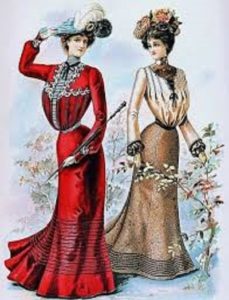
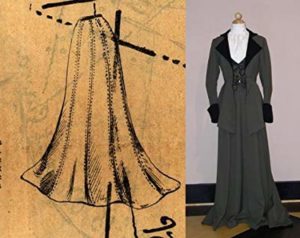
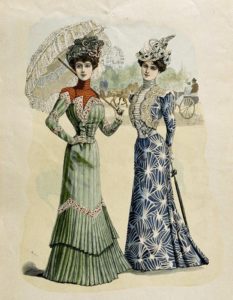
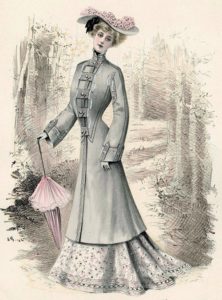
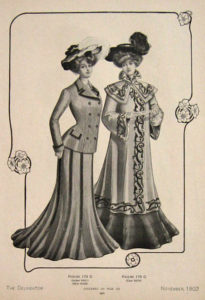
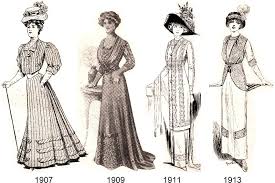
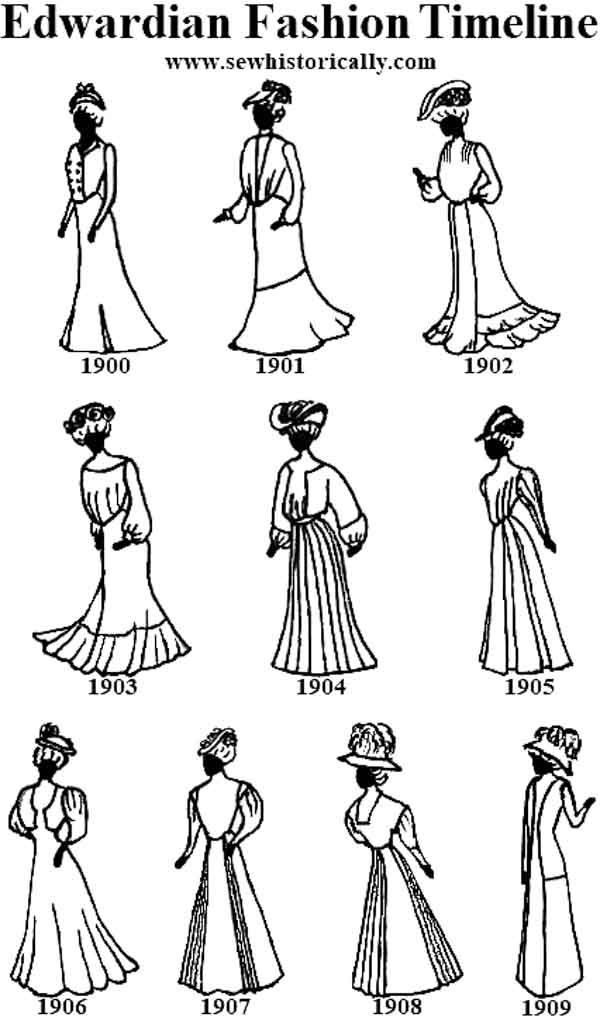
 1900
1900